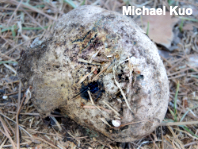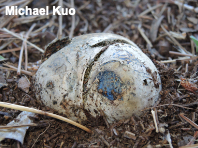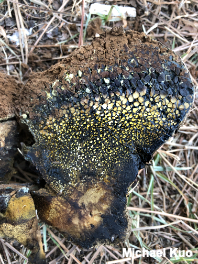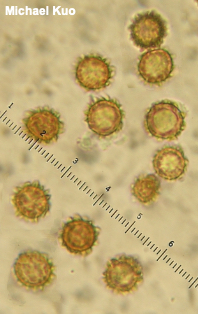| Major Groups > Puffballs & Others > Pisolithus arhizus |

|
Pisolithus arhizus [ Basidiomycota > Boletales > Sclerodermataceae > Pisolithus . . . ] by Michael Kuo Documented from southern Europe, Africa, and Japan, Pisolithus arhizus is a mycorrhizal associate of pines, oaks, and cedars. It features a pale, nearly whitish "shell" that encases an interior composed, initially, of pea-sized spore packages. As the fungus matures, cinnamon-colored spore dust replaces the spore packages, beginning at the top of the mushroom and moving downward. Eventually, the whole thing disintegrates and spore dust is released. Within southern Europe, similar species include Pisolithus albus and Pisolithus microcarpus (both associated with eucalyptus and featuring smaller spores), Pisolithus arenarius (with a somewhat darker outer skin), and Pisolithus calongei (associated with rockroses, spines on spores often coalescing). The illustrated and described collection, from the Italian Riviera, was made in an urban grove of one of my favorite trees, stone pine, well known to the world from Italian landscapes in film and paintings, featuring stunning mature bark and a sparse, umbrella-shaped crown. Although the species name arhizus is widely applied in North America, recent research (Martin et al. 2002, Lebel et al. 2018) does not support the idea; see Pisolithus arenarius for the North American species. Description: Ecology: Mycorrhizal with pines, oaks, and cedars; growing alone, scattered, or in small groups; often found in gravel, sandy soil, in ditches, on lawns, and so on; summer and fall, or over winter in warm climates; southern Europe, Africa, and Japan. The illustrated and described collection is from the Italian Riviera. Fruiting Body: 5–16 cm high; 4–10 cm across; ball-shaped to top-shaped when young, with a narrowed, not-quite-stemlike base; stretching out with maturity to become top-shaped to widely cylindric; outer surface at first very pale brownish to dull yellowish or nearly whitish, developing cracks and fissures, and eventually breaking up to expose the interior; outer rind about 1 mm thick, fragile; interior at first packed with pea-sized, yellowish to whitish or cinnamon brown spore packages embedded in blackish gel, disintegrating from the top downward to become a mass of cinnamon brown spore dust; basal area with yellowish to brownish flesh. Odor: Not distinctive. Spore Print: Cinnamon brown. Microscopic Features: Spores 5–8 µm excluding ornamentation; globose; densely echinate with isolated spines 1–1.5 µm long and about 0.5 µm wide at the base; thick-walled; golden in KOH. REFERENCES: (Scopoli, 1786) Rauschert, 1959. (Phillips, 1981; Cairney, 2002; Martin et al., 2002; Phosri et al., 2012; Gminder & Böhning, 2017; Lebel et al., 2018.) Herb. Kuo 09291801. This site contains no information about the edibility or toxicity of mushrooms. |
© MushroomExpert.Com |
|
Cite this page as: Kuo, M. (2018, December). Pisolithus arhizus. Retrieved from the MushroomExpert.Com Web site: http://www.mushroomexpert.com/pisolithus_arhizus.html |



